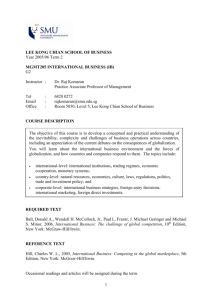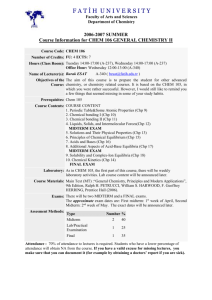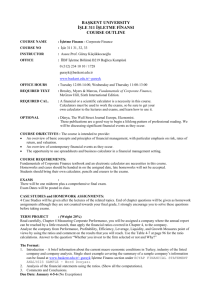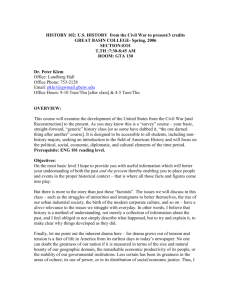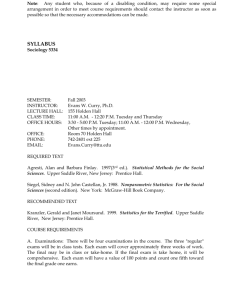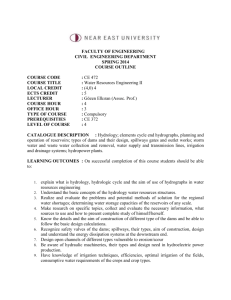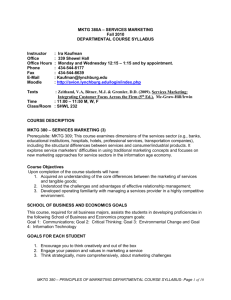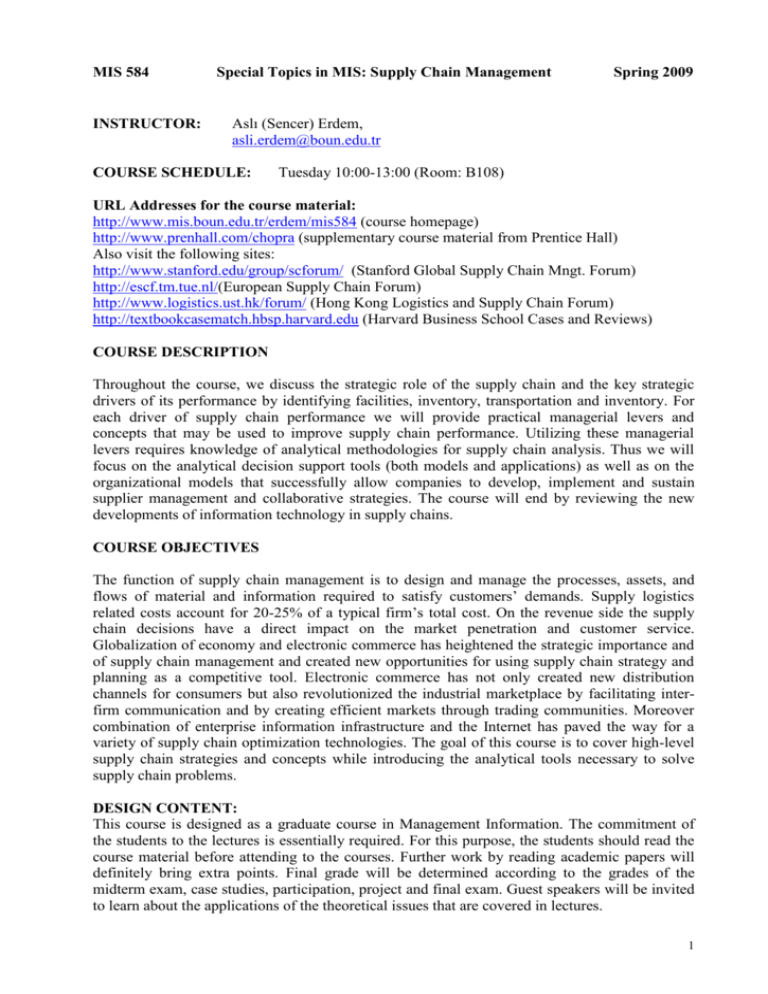
MIS 584
INSTRUCTOR:
Special Topics in MIS: Supply Chain Management
Spring 2009
Aslı (Sencer) Erdem,
asli.erdem@boun.edu.tr
COURSE SCHEDULE:
Tuesday 10:00-13:00 (Room: B108)
URL Addresses for the course material:
http://www.mis.boun.edu.tr/erdem/mis584 (course homepage)
http://www.prenhall.com/chopra (supplementary course material from Prentice Hall)
Also visit the following sites:
http://www.stanford.edu/group/scforum/ (Stanford Global Supply Chain Mngt. Forum)
http://escf.tm.tue.nl/(European Supply Chain Forum)
http://www.logistics.ust.hk/forum/ (Hong Kong Logistics and Supply Chain Forum)
http://textbookcasematch.hbsp.harvard.edu (Harvard Business School Cases and Reviews)
COURSE DESCRIPTION
Throughout the course, we discuss the strategic role of the supply chain and the key strategic
drivers of its performance by identifying facilities, inventory, transportation and inventory. For
each driver of supply chain performance we will provide practical managerial levers and
concepts that may be used to improve supply chain performance. Utilizing these managerial
levers requires knowledge of analytical methodologies for supply chain analysis. Thus we will
focus on the analytical decision support tools (both models and applications) as well as on the
organizational models that successfully allow companies to develop, implement and sustain
supplier management and collaborative strategies. The course will end by reviewing the new
developments of information technology in supply chains.
COURSE OBJECTIVES
The function of supply chain management is to design and manage the processes, assets, and
flows of material and information required to satisfy customers’ demands. Supply logistics
related costs account for 20-25% of a typical firm’s total cost. On the revenue side the supply
chain decisions have a direct impact on the market penetration and customer service.
Globalization of economy and electronic commerce has heightened the strategic importance and
of supply chain management and created new opportunities for using supply chain strategy and
planning as a competitive tool. Electronic commerce has not only created new distribution
channels for consumers but also revolutionized the industrial marketplace by facilitating interfirm communication and by creating efficient markets through trading communities. Moreover
combination of enterprise information infrastructure and the Internet has paved the way for a
variety of supply chain optimization technologies. The goal of this course is to cover high-level
supply chain strategies and concepts while introducing the analytical tools necessary to solve
supply chain problems.
DESIGN CONTENT:
This course is designed as a graduate course in Management Information. The commitment of
the students to the lectures is essentially required. For this purpose, the students should read the
course material before attending to the courses. Further work by reading academic papers will
definitely bring extra points. Final grade will be determined according to the grades of the
midterm exam, case studies, participation, project and final exam. Guest speakers will be invited
to learn about the applications of the theoretical issues that are covered in lectures.
1
Evaluation
Midterm Exam
Case Studies
Class Participation
Project-Final exam
30%
30%
10%
30%
Case Studies
There will be some case studies which should be prepared in groups of 1-2 students. You may
interchange ideas but each group should prepare the homework with their own words. On the
day of submission (usually one week later), a group will be asked to present their study and
others will be expected to criticise them. Discussions will be graded.
Project
The final project can be done individually or in groups of 2. All reports should be typed with a
maximum of 15 pages (1.5 line-spacing, 11 or 12 pt. font size).
There are three possible outcomes from a project report as follows:
To analyze an existing logistics process and suggest any improvements that are needed to be
made. Examples include a study of the distribution system and store deliveries at McDonalds,
design of a logistics system for a manufacturer of refrigeration equipment, and an analysis of
intermodal movement for a railroad.
To study supply chain practices in industry from the point of describing risks, benefits, best
practices along with industry examples of each.
To identify a business opportunity (for example selling furniture on line) involving a product
and build a business plan with a focus on supply chain issues. The goal is to identify the
business opportunity and design the ideal supply chain for it. The project should include
implementation details.
PREREQUISITE:
Operations Management is recommended. Basic statistics, operations research knowledge and
analytical thinking capabilities are assets.
TEXTBOOK:
Chopra S. and Meindl. P., Supply Chain Management: Strategy, Planning, and Operations, 3rd.
Edition, Pearson Prentice Hall, 2007.
Other References
Simchi-Levi, D., Kaminsky, P. and Simchi-Levi E., Designing and Managing the Supply
Chain: Concepts, Strategies, and Case Studies, 2nd Edition, McGraw-Hill, 2003.
Shapiro, J., F., Modeling the Supply Chain, Duxbury, 2001.
Vollmann, T.E., Berry, W.L., Whybark, D.C. and Jacobs, F.R., Manufacturing Planning and
Control for Supply Chain Management, McGraw-Hill, 2005.
de Kok, A.G. and Graves, S. C. ed., Supply Chain Management: Design, Coordination and
Operation, Elsevier, 2003.
Voss, S. and Woodruff, D.L., Introduction to Computational Optimization Models for
Production Planning in a Supply Chain, Springer-Verlag, 2003.
Stadtler, H. and Kilger, C., ed., Supply Chain Management and Advanced Planning:
Concepts, Models, Software and Case Studies, 2nd Edition, Springer-Verlag, 2002.
Ayers, J.B., Handbook of Supply Chain Management, CRC Press, 2000.
2
COURSE OUTLINE
Week
Date
Title
1
Feb., 17
Part I: Building a Strategic Framework to Analyze Supply Chains
Chp 1: Understanding the Supply Chain
2
Feb., 24
Chp. 2: Supply Chain Performance: Achieving Strategic Fit
3
March, 3
Chp. 3: Supply Chain Drivers and Metrics
HW-Case Study: Seven Eleven-Japan (visit textbook website)
4
March, 10
5
March, 17
Part II: Designing the Supply Chain Network
Chp. 4: Designing the Distribution Networks and Applications to E-Business
Chp. 5: Network Design in the Supply Chain
HW-Case Study: Managing Growth at Sportstuff.com
6
March, 24
Part III: Planning Demand and Supply in a Supply Chain
Chp 8: Aggregate Planning in the Supply Chain
Chp 9: Planning Supply and Demand in the Supply Chain: Managing
Predictable Variability
HW-Case Study: Specialty Packaging Corporation
7
March, 31
Part IV: Planning and Managing Inventories in a Supply Chain
Chp. 10: Managing Economies of Scale in the Supply Chain
HW-Case Study: Mintendo Game Girl
Chp. 10: Managing Economies of Scale in the Supply Chain
8
April, 7
Project Proposal
9
April, 14
Part VI: Managing Cross Functional Drivers in the Supply Chain
Chp. 14: Sourcing Decisions in a Supply Chain
10
April, 21
Chp. 15: Pricing and Revenue Management in the Supply Chain
11
April, 28
12
May, 5
Chp. 16: Information Technology and the Supply Chain
Chp. 17: Coordination in the Supply Chain
13
May, 12
MIDTERM EXAM
14
May, 19
Spring Break - No Lectures
National Holiday - No Lectures
3




